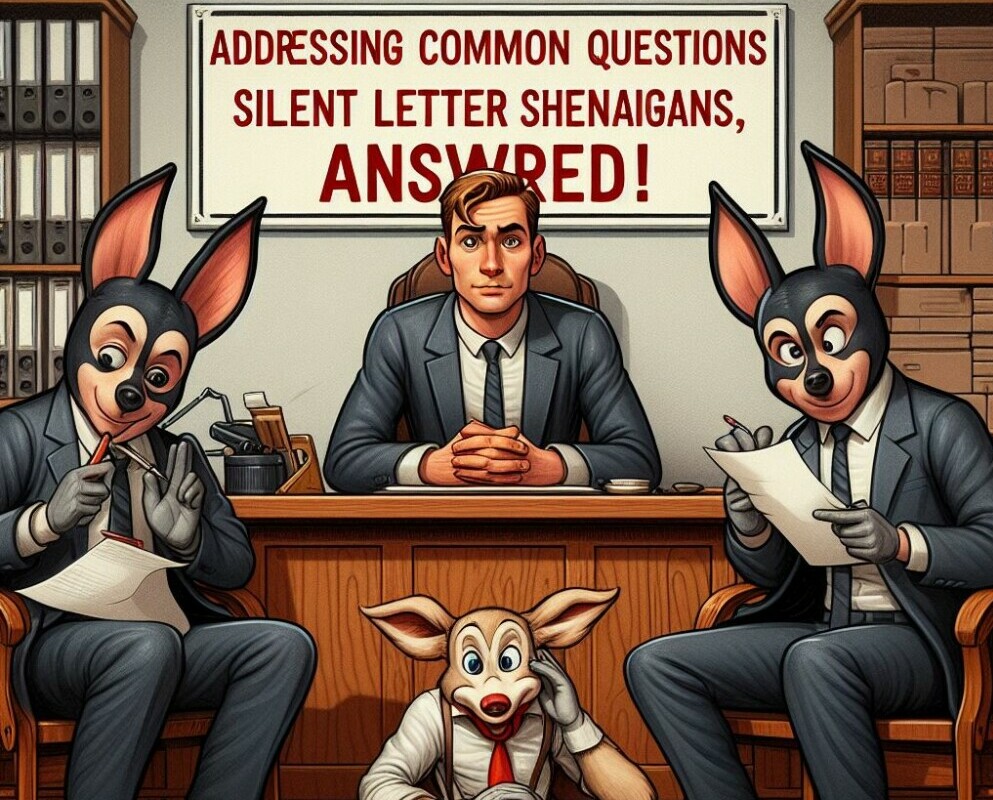- Know (silent k)
- Island (silent s)
- Debt (silent b)
- Castle (silent t)
- Wrong (silent w)
- Doubt (silent b)
- Subtle (silent b)
- Listen (silent t)
- Pneumonia (silent p)
- Lamb (silent b)
Ever Stare at a Word in English and Think, “Wait, What?”
 Remember that sinking feeling you get when you encounter a word in English that just doesn’t seem to follow the rules? You sound it out carefully, but the pronunciation doesn’t match the letters staring back at you. The culprit? Silent letters! Those sneaky characters hiding in plain sight, tripping up both ESL learners and even native speakers at times. (We’ve all been there, right?)
Remember that sinking feeling you get when you encounter a word in English that just doesn’t seem to follow the rules? You sound it out carefully, but the pronunciation doesn’t match the letters staring back at you. The culprit? Silent letters! Those sneaky characters hiding in plain sight, tripping up both ESL learners and even native speakers at times. (We’ve all been there, right?)
But fear not! This guide is about to shed light on the mystery of silent letters. We’ll delve into their fascinating history, explore the most common offenders, and equip you with strategies to conquer them once and for all. Whether you’re an ESL student eager to master English pronunciation, or a curious native speaker wanting to brush up on the quirks of your own language, this article is your ultimate silent letter survival guide. So, grab a cup of coffee, settle in, and let’s unlock the secrets of those silent troublemakers!
What Are Silent Letters?
 Ah, silent letters. Those mischievous fellows that love to play hide-and-seek in English words. But unlike a playful game of childhood, silent letters can cause genuine confusion when it comes to pronunciation. So, let’s break down exactly what they are and how they impact the way we speak English.
Ah, silent letters. Those mischievous fellows that love to play hide-and-seek in English words. But unlike a playful game of childhood, silent letters can cause genuine confusion when it comes to pronunciation. So, let’s break down exactly what they are and how they impact the way we speak English.
Silent Letter Sleuths: Unveil The Mystery
By definition, a silent letter is a letter in a word that isn’t pronounced. It might seem nonsensical at first glance, but these silent characters actually play a significant role in English spelling and pronunciation. They can completely change the vowel sound that comes before them (think of the long “a” in “cake” versus the short “a” in “cat”) or even differentiate between words that sound identical otherwise (known as homophones). Imagine the chaos if “peace” and “piece” were spelled the same way!
The Silent “E”: A Vowel In Disguise
The most common silent letter suspect? The elusive silent “e.” This sneaky character often sits at the end of a word, acting like a magic wand that transforms the vowel before it. Take the words “bit” and “bite.” The single “i” in “bite” produces a short, choppy sound. But add the silent “e” in “bite,” and suddenly the “i” stretches out into a long, delightful “ee” sound. This silent “e” magic isn’t always consistent, though. Words like “love” and “have” defy the pattern, keeping their vowel sounds short despite the silent “e” at the end. That’s the beauty (and sometimes frustration) of English – there are always exceptions to the rule!
Why Do Silent Letters Exist?
 Silent letters might seem like a cruel trick English plays on learners, but there’s actually a fascinating history behind their existence. Buckle up, word detectives, because we’re about to delve into the time-traveling world of etymology (the study of word origins) to uncover the secrets of these silent characters.
Silent letters might seem like a cruel trick English plays on learners, but there’s actually a fascinating history behind their existence. Buckle up, word detectives, because we’re about to delve into the time-traveling world of etymology (the study of word origins) to uncover the secrets of these silent characters.
Borrowing Bonanza: Echoes From The Past
Imagine English as a magpie, a bird known for collecting shiny objects. Throughout history, English has borrowed words from a vast array of languages, like French, Latin, and Greek. These borrowed words often came with their original spellings, which sometimes included silent letters that reflected pronunciations in those languages. Take the word “debt,” for example. In its Latin ancestor “debitum,” the “b” was clearly pronounced. But when English adopted the word, the spelling stuck, even though the pronunciation of the “b” eventually faded away. Silent letters, in this case, act like tiny historical markers, reminding us of the rich tapestry of languages that have influenced English.
The Great Vowel Shift: A Sound Revolution
Fast forward a few centuries, and English underwent a dramatic sound change known as the Great Vowel Shift (roughly between the 15th and 16th centuries). Think of it as a giant vowel swap meet! Vowel sounds shuffled around, completely altering the pronunciation of many words. The letter “k” in “knight,” for instance, was once pronounced just like the “k” in “key.” However, the Great Vowel Shift changed the sound of the surrounding vowels, leaving the “k” stranded and silent in its modern form. Silent letters, in this case, became relics of an earlier pronunciation system, a reminder of how the English language has evolved over time.
Common Silent Letters And Examples: Unveiling The Usual Suspects
 Now that we’ve cracked the code on why silent letters exist, let’s get down to business and identify the most common culprits causing pronunciation mayhem! We’ll explore a variety of silent letters and uncover the sneaky tricks they play in some of your favorite (or perhaps most frustrating) English words.
Now that we’ve cracked the code on why silent letters exist, let’s get down to business and identify the most common culprits causing pronunciation mayhem! We’ll explore a variety of silent letters and uncover the sneaky tricks they play in some of your favorite (or perhaps most frustrating) English words.
The Silent “E”: A Master Of Disguise
As we learned earlier, the silent “e” is the champion of silent letters. It typically takes a vacation at the end of a word, magically transforming the vowel before it into a long and delightful sound. Look at the words “pin” and “pine.” The single “i” in “pin” makes a short, clipped sound. But add the silent “e” to “pine,” and voila! The “i” stretches out into a long “ee” sound, completely changing the meaning of the word.
However, our friend the silent “e” isn’t always predictable. Words like “love” and “have” break the pattern, keeping their vowel sounds short despite the silent “e” at the end. This is where things can get tricky, but remember, exceptions are part of the charm (and sometimes the challenge) of the English language!
Silent Consonants: The Sneaky Squad
Silent consonants are another group of masters of disguise. They blend in seamlessly with the spelling of a word, only to remain blissfully silent when it comes to pronunciation. Here are some of the most common silent consonants and their sneaky hiding places:
- The “b”: This sneaky character likes to pop up in unexpected places, like “debt” (a historical borrowing from Latin) and “lamb” (where the etymology is a bit fuzzy).
- The “g”: We see the silent “g” lurking in words like “champagne” (influenced by French) and “sign” (with Latin roots).
- The “k”: This silent knight can be found in words like “knife” (borrowed from another language) and “know” (another historical borrowing).
We’ll continue to explore the world of silent consonants in the next section, uncovering more of their secret hiding places and the words they make silent accomplices to!
Strategies for Mastering Silent Letters: Conquering the Silent Squad
 So, you’ve encountered a silent letter and it’s thrown a wrench into your pronunciation plans? Fear not, intrepid word warriors! Here are some battle-tested strategies to help you master silent letters and emerge victorious:
So, you’ve encountered a silent letter and it’s thrown a wrench into your pronunciation plans? Fear not, intrepid word warriors! Here are some battle-tested strategies to help you master silent letters and emerge victorious:
Look for Word Families: The Power of Connection
The English language loves throwing curveballs, but it also offers helpful patterns. Often, silent letters will remain silent in a group of related words, also known as a word family. Take the word “comb.” The “b” is silent, and you might feel defeated. But look at its cousin, “come.” Here, the “b” is happily pronounced. This connection can be a powerful tool! By building your knowledge of word families, you can start to make educated guesses about the pronunciation of silent letters in unfamiliar words.
Etymology Can Be Your Ally (But Use Caution!)
Etymology, the study of word origins, can sometimes offer clues about silent letters. For instance, knowing that “debt” comes from the Latin word “debitum” (where the “b” was pronounced) might help you understand why the “b” remains silent in English. However, etymology isn’t a foolproof method. The word “island” has silent letters reflecting its historical borrowing, but a related word like “isle” doesn’t follow the same pattern. So, use etymology as a helpful hint, but don’t rely on it solely.
Dictionaries: Your Ultimate Silent Letter Weapon
Think of a dictionary as your secret weapon against silent letters. A good dictionary will not only provide the definition of a word but also include a pronunciation guide, often using the International Phonetic Alphabet (IPA). This pronunciation guide is like a decoder ring, revealing the exact sounds of each letter, including those sneaky silent ones. Make using a dictionary a habit, and soon you’ll be confidently pronouncing even the trickiest words with silent letters.
Practice Makes Perfect: Embrace Spaced Repetition
Learning doesn’t happen overnight, especially when it comes to the quirks of silent letters. Here’s where the power of spaced repetition comes in. This learning technique involves reviewing information at gradually increasing intervals, helping you move words from short-term to long-term memory. Flashcards are a classic example of spaced repetition, but there are also many spaced repetition apps available online. Use these tools to create decks specifically focused on silent letters, and watch your pronunciation confidence soar!
Silent Letters Unmasked: No More Mystery, Just Mastery!
 Phew! We’ve delved deep into the world of silent letters, from their surprising history to the sneaky tricks they play in our favorite words. Remember, silent letters aren’t random annoyances; they’re fascinating relics of the English language’s evolution and the words we’ve borrowed from other cultures.
Phew! We’ve delved deep into the world of silent letters, from their surprising history to the sneaky tricks they play in our favorite words. Remember, silent letters aren’t random annoyances; they’re fascinating relics of the English language’s evolution and the words we’ve borrowed from other cultures.
Now that you’re armed with this knowledge, here’s how to transform silent letters from foes to friends:
- Become a Word Family Detective: Look for connections between words, and use those relationships to predict silent letter pronunciation.
- Befriend Etymology (with Caution): Understanding word origins can offer clues, but remember, exceptions lurk around every corner!
- Unleash the Power of Dictionaries: A good dictionary with a pronunciation guide is your ultimate silent letter slayer.
- Embrace Spaced Repetition: Flashcards and spaced repetition apps are your secret weapons for memorizing silent letter pronunciations.
By putting these strategies into action, you’ll be well on your way to mastering silent letters and pronouncing English with confidence. Remember, even native speakers encounter silent letter challenges sometimes. The key is to embrace the quirkiness, keep practicing, and celebrate your progress!
So, the next time you encounter a silent letter, don’t feel defeated. Think of it as an exciting opportunity to unlock another secret of the fascinating English language!
Addressing Common Questions: Silent Letter Shenanigans, Answered!
 Conquering silent letters is a journey, and you might still have some questions. Here’s a quick Q&A session to address some common silent letter roadblocks:
Conquering silent letters is a journey, and you might still have some questions. Here’s a quick Q&A session to address some common silent letter roadblocks:
Q: Are silent letters ever pronounced?
- A: In rare cases, yes! Certain dialects or accents might pronounce silent letters that are typically silent in standard English. For example, some British pronunciations of “tomato” include the “t” sound.
Bonus Tip: Listening to different English accents can be a fun way to explore these variations and expand your understanding of the language.
Q: How many silent letters are there in English?
- A: That’s a tricky one! Because pronunciation can vary depending on dialect and context, it’s difficult to give a definitive answer. However, silent letters are quite prevalent in English spelling, and the strategies in this article will equip you to handle the most common ones.
Q: What about other silent letters, like the “w” in “sword”?
- A: Excellent question! We focused on the most common silent consonants, but there are others like the “w” in “sword” or the “p” in “psychology.” The same strategies we discussed (word families, etymology, dictionaries) can be applied to these as well.
Bonus Tip: Pay attention to pronunciation patterns in the specific word families you encounter. For instance, the “w” is often silent after the vowel “o” (sword, answer, write).
Q: This all seems overwhelming! Any final words of encouragement?
- A: Absolutely! Learning a language is a journey, and encountering silent letters is a normal part of that journey. Don’t get discouraged – celebrate every new word you master, and remember, even native speakers grapple with silent letters sometimes. Embrace the challenge, keep practicing, and you’ll be a silent letter pro in no time!
Leave comments and questions in the comments section below. I will promptly reply


Hi there –
English is my second language. When I moved to the U.S., a while ago, I struggled with learning English, especially silent letters. Practicing words like subtle or Lamb is the best way to become accustomed to silent letters.
English is a quirky language with interesting nuances. Silent letters and subtle differences in the meaning of words are some of the challenges. Regardless, it is a universal language that unites millions of people.
Hi Godwin, thanks for your comments. It’s nice to hear from an ESL person to validate the article. When I tell my students that certain letters are silent, I get some strange looks. I tell them I don’t know why the letter is there if it doesn’t have a purpose. I try to make a joke about. Sometimes, I actually get a laugh
Leave comments and questions here anytime. I will promptly reply.
KBob
I teach ESL adults from Brazil, Ukraine, Iran, and Kazakhstan. I’ve been researching how to present silent letters and your site is the best one I’ve found. Thank you for a quick explanation of the etymology. My students frequently ask, “But why?” during many lessons and I usually say, “English is a hard language and you just have to memorize a lot of it without knowing the reasons why.” They accept my answer, sort of… Rosie
Hi Rosie, thanks for your comments. It’s always good to hear from ohter ESL teachers. I’m wondering if you’re referring to my “Rule number 1-English is a crazy language” explanation. It’s the best explanation I know of. Leave comments and questions here anytime.
KBob